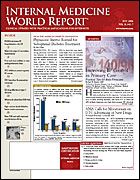Publication
Article
Internal Medicine World Report
Few Hypertensive Patients With Diabetes Reach bp Goals
Author(s):
NEW YORK CITY—Three fourths of patients with type 2 diabetes and comorbid hypertension do not achieve blood pressure (BP) control, according to data presented at the 21st annual scientific meeting of the American Society of Hypertension.
“Because uncontrolled blood pressure may increase the rate of cardiovascular and renal complications, it is critical that additional public health efforts are made to support more aggressive treatment of persons with hypertension and type 2 diabetes,” said Dong-Churl Suh, MBA, PhD, assistant professor of pharmacy, Rutgers University, Piscataway, NJ.
Data were analyzed from 15.4 million patients with comorbid diabetes and hypertension who participated in the National Health and Nutrition Examination Survey (NHANES), from 1988 through 1994 or from 1999 through 2002.
Hypertension was defined as a physician diagnosis, current use of antihypertensive medications, systolic BP ≥130 mm Hg, or diastolic BP ≥80 mm Hg. Type 2 diabetes was defined as a physician diagnosis at ≥30 years of age, current use of insulin or oral antidiabetic drugs, or a hemoglobin (Hb) A1c level of ≥7%. BP was deemed to be controlled if it dropped below 130/80 mm Hg.
Patients with diabetes are twice as likely to have hypertension as their nondiabetic counterparts, Dr Suh emphasized. Obesity may be a common link between the 2 disorders, although additional factors, such as insulin resistance and autonomic dysfunction, may also be involved.
He noted that obesity, hypertension, impaired glucose tolerance, insulin resistance, and dyslipidemia are all components of the metabolic syndrome.
P
P
P
P
Results of the analysis showed that mean BP decreased from 141/76 to 139/70 mm Hg ( = .06 systolic; <.05 diastolic). Overall, BP control rates increased from 13.7% to 24.7% ( <.01). The use of antihypertensive agents also increased significantly, from 52% to 62.7% ( <.01).
“Thus, while blood pressure control rates increased over the observation period, less than 25% of patients achieved blood pressure control during 1999 through 2002,” Dr Suh observed.
Even more alarming, he said, was that in about 9 of 10 patients, BP and HbA1c were not controlled to recommended goals.
Effective BP management is extremely important in patients with type 2 diabetes. “Blood pressure control is paramount in this high-risk population and can reduce cardiovascular events such as heart disease and stroke by roughly 33% to 50% and microvascular disease such as eye, kidney, and nerve disease by nearly 33%,” Dr Suh said.
“Every 10-mm Hg reduction in systolic blood pressure is associated with a 12% decrease in diabetes-related complications,” he added.
He emphasized that several potential limitations must be considered when analyzing these study results. “Medication use is self-reported and thus may be subject to misclassification in measured treatment regimens. NHANES may be subject to survival bias, where some individuals with hypertension and type 2 diabetes having the poorest control may have died over time and not participated in the surveys.”
The American Diabetes Association changed their diagnostic criteria for diabetes in 1997, which may have influenced the estimated prevalence of type 2 diabetes between the 2 NHANES survey periods.





